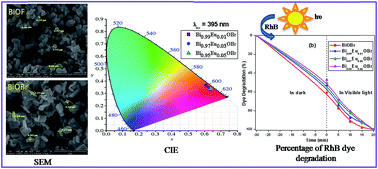Synthesis of Eu3+-activated BiOF and BiOBr phosphors: photoluminescence, Judd–Ofelt analysis and photocatalytic properties†
Abstract
A series of Bi1−xEuxOX (X = F and Br; x = 0, 0.01, 0.03 and 0.05) phosphors were synthesized at relatively low temperature and short duration (500 °C, 1 h). Rietveld refinement results verified that all the compounds were crystallized in the tetragonal structure with space group P4/nmm (no. 129). Photoluminescence spectra exhibit characteristic luminescence 5D0 → 7FJ (J = 0–4) intra-4f shell Eu3+ ion transitions. The magnetic dipole (5D0 → 7F1) transition dominates the emission of BiOF:Eu3+, while the electric dipole (5D0 → 7F2) peak was stronger in BiOBr:Eu3+ phosphors. The evaluated CIE color coordinates for Bi0.95Eu0.05OBr (0.632, 0.358) are close to the commercial Y2O3:Eu3+ (0.645, 0.347) and Y2O2S:Eu3+ (0.647, 0.343) red phosphors. Intensity parameters (Ω2, Ω4) and various radiative properties such as transition rates (A), branching ratios (β), stimulated emission cross-section (σe), gain bandwidth (σe × Δλeff) and optical gain (σe × τ) were calculated using the Judd–Ofelt theory. It was observed that BiOBr:Eu3+ phosphors have a long lifetime (τ) and better optical gain (σe × τ) as compared to reported Eu3+ doped materials. Furthermore, these compounds exhibit excellent photocatalytic activity for the degradation of rhodamine B dye under visible light irradiation. The determined radiative properties and photocatalytic results revealed that BiOBr:Eu3+ phosphors have potential applications in energy and environmental remedies, such as to develop red phosphors for white light-emitting diodes, red lasers and to remove toxic organic industrial effluents.


 Please wait while we load your content...
Please wait while we load your content...